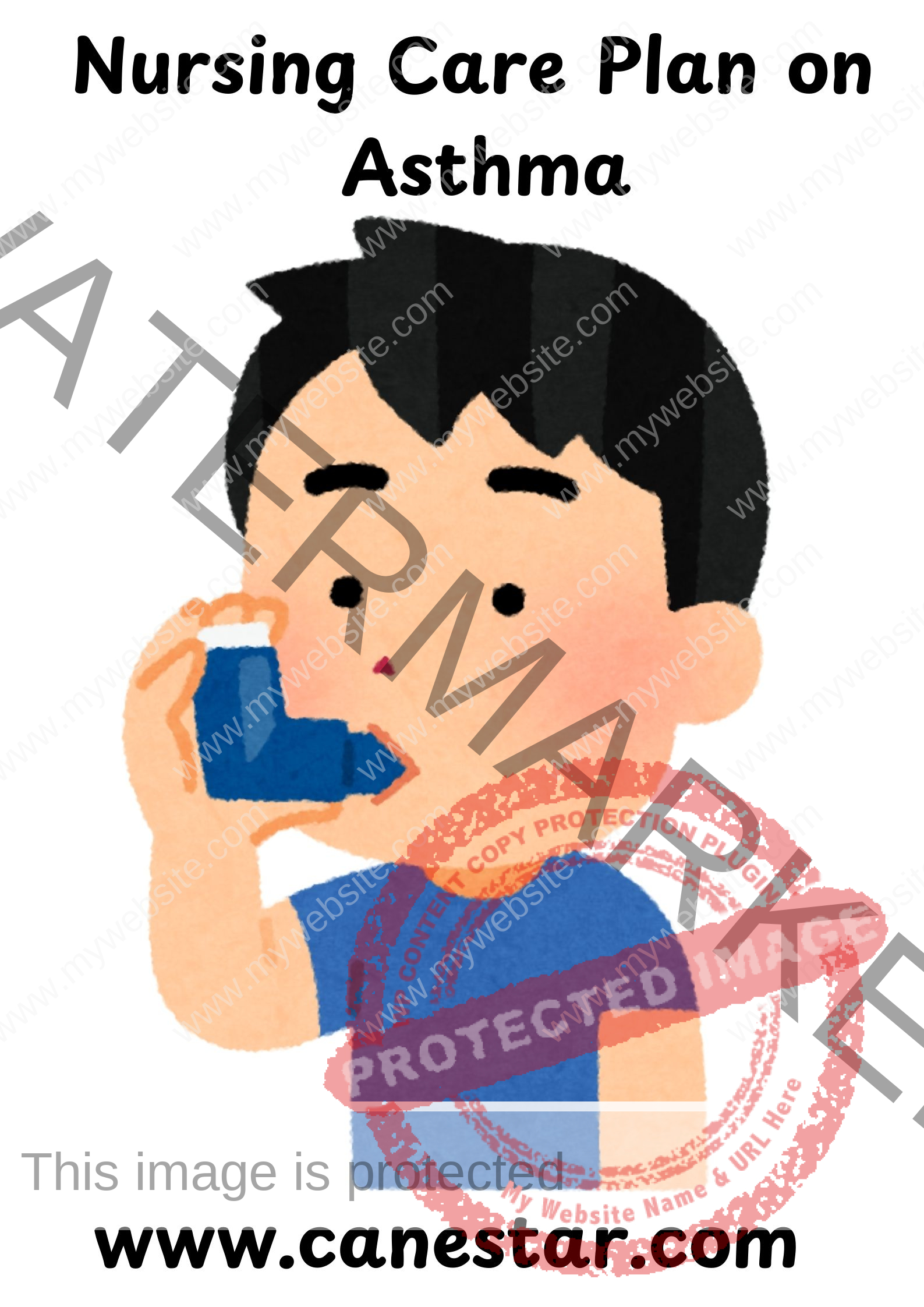NURSING CARE PLAN FOR ASTHMA
NURSING CARE PLAN FOR ASTHMA
NURSING CARE PLAN ON ASTHMA
Asthma is a chronic inflammatory condition of the airways that causes episodes of wheezing, shortness of breath, chest tightness, and coughing. It occurs when the airways become inflamed, narrowed, and produce extra mucus, making it difficult to breathe.
Causes of Asthma:
Asthma can be triggered by various factors, and it can be classified into allergic asthma and non-allergic asthma. Common causes and triggers include:
Allergens:
- Pollen
- Dust mites
- Animal dander
- Mold
Irritants:
- Tobacco smoke
- Pollution
- Strong odors or fumes (e.g., chemicals, perfumes)
Respiratory infections:
- Common colds
- Flu
- Sinus infections
Physical activity:
- Exercise-induced asthma (especially in cold or dry environments)
Weather conditions:
- Cold air
- Changes in humidity
Medications:
- Non-steroidal anti-inflammatory drugs (NSAIDs) like aspirin
- Beta-blockers (for heart disease)
Stress and strong emotions:
- Anxiety or panic attacks
- Laughter or crying
Gastroesophageal reflux disease (GERD):
- Acid reflux can worsen asthma symptoms.
Symptoms of Asthma:
Asthma symptoms vary from person to person and can be mild, moderate, or severe. Common symptoms include:
- Wheezing (a whistling sound when breathing)
- Shortness of breath
- Chest tightness
- Coughing, especially at night or early in the morning
- Increased mucus production
- Fatigue during or after physical activity
In severe cases, asthma attacks can occur, which may require immediate medical attention.
Types of Asthma:
Allergic (Extrinsic) Asthma: Triggered by exposure to allergens.
Non-Allergic (Intrinsic) Asthma: Triggered by irritants, stress, infections, or exercise.
Exercise-Induced Asthma (EIA): Symptoms occur during or after physical activity.
Occupational Asthma: Triggered by workplace irritants.
Nocturnal Asthma: Symptoms worsen at night.
Diagnosis:
To diagnose asthma, healthcare providers perform several tests, including:
Medical history and physical exam: To assess symptoms and risk factors.
Spirometry: A test that measures lung function, specifically the amount of air a person can exhale after a deep breath and how fast they can do so.
Peak flow meter: A device that measures the force of air you can exhale.
Allergy testing: To identify specific allergens that trigger asthma symptoms.
Bronchoprovocation test: Exposing the patient to triggers (exercise or allergens) under medical supervision to check for airway reactivity.
Nursing Diagnosis:
Ineffective Airway Clearance related to bronchoconstriction, increased mucus production, and airway inflammation as evidenced by wheezing, dyspnea, and coughing.
Assessment:
Subjective Data:
- Patient reports difficulty breathing, chest tightness, and coughing, especially at night or after exposure to triggers (e.g., allergens, exercise, cold air).
- Reports of anxiety or fear related to breathing difficulty.
Objective Data:
- Wheezing on auscultation.
- Use of accessory muscles to breathe.
- Increased respiratory rate and heart rate.
- Decreased oxygen saturation (SpO2).
- Cough with or without sputum.
Goals:
- Maintain a clear airway and normal breathing pattern.
- Improve oxygenation with an SpO2 level ≥ 95%.
- Reduce anxiety and promote comfort.
- Educate the patient on managing asthma triggers and medications.
- Prevent asthma exacerbations and complications.
Nursing Interventions:
Monitor Respiratory Status:
- Assess breath sounds for wheezing, crackles, or diminished airflow.
- Monitor respiratory rate, depth, and effort regularly.
- Monitor oxygen saturation using pulse oximetry. Administer supplemental oxygen if SpO2 is below 95%.
- Assess peak expiratory flow rate (PEFR) if the patient uses a peak flow meter to monitor lung function.
Administer Medications:
- Administer bronchodilators (e.g., albuterol) as prescribed to relieve bronchoconstriction.
- Administer anti-inflammatory agents (e.g., corticosteroids) to reduce airway inflammation.
- Provide oxygen therapy as needed to maintain adequate oxygenation.
- Administer mucolytics or expectorants to help clear mucus, if ordered.
Positioning:
- Position the patient in high Fowler’s position (sitting upright) to maximize lung expansion and ease breathing.
- Encourage tripod positioning (sitting with hands on knees or leaning forward) during acute episodes to aid in breathing.
Promote Airway Clearance:
- Encourage deep breathing and coughing exercises to mobilize secretions.
- Provide chest physiotherapy (e.g., percussion or vibration) if necessary.
- Use a humidifier or provide hydration to help thin mucus and make it easier to expectorate.
Monitor for Signs of Exacerbation:
- Monitor for early warning signs of asthma exacerbation, such as increased wheezing, shortness of breath, or cough.
- Educate the patient to use their peak flow meter to detect declining lung function before severe symptoms occur.
- Assess the patient’s use of rescue inhalers and ensure they know when and how to use them.
Reduce Anxiety and Promote Comfort:
- Use calming techniques and provide emotional support during acute asthma attacks to reduce anxiety.
- Provide a quiet, low-stress environment to minimize triggers.
- Reassure the patient to help reduce fear and panic associated with breathing difficulties.
Patient Education:
- Teach the patient about asthma triggers (e.g., allergens, exercise, smoke, cold air) and how to avoid or manage them.
- Educate the patient on correct inhaler technique (both rescue and maintenance inhalers).
- Discuss the importance of medication adherence, even when symptoms are controlled.
- Encourage the use of a peak flow meter to monitor lung function regularly.
- Teach early warning signs of asthma exacerbation and when to seek medical help.
- Educate about asthma action plans to manage exacerbations at home effectively.
Collaborate with Health Care Providers:
- Consult a respiratory therapist to assist with breathing exercises or advanced airway clearance techniques if needed.
- Refer the patient for allergist consultation if asthma is triggered by allergens.
- Ensure the patient is enrolled in a follow-up plan for regular asthma management and care.
Evaluation:
Short-term goal:
- The patient will maintain an open airway and have improved breath sounds with a respiratory rate within normal limits.
- The patient will have SpO2 ≥ 95% within 24 hours of initiating treatment.
Long-term goal:
- The patient will demonstrate knowledge of asthma triggers and medication management.
- The patient will report fewer asthma exacerbations and maintain controlled asthma symptoms.


